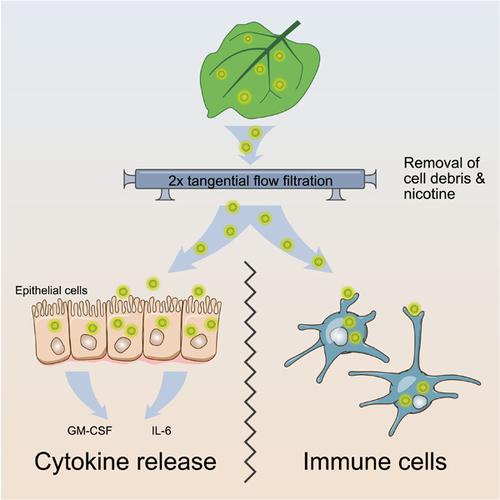当前位置:
X-MOL 学术
›
Biotechnol. Bioeng.
›
论文详情
Our official English website, www.x-mol.net, welcomes your
feedback! (Note: you will need to create a separate account there.)
Plant-derived protein bodies as delivery vehicles for recombinant proteins into mammalian cells.
Biotechnology and Bioengineering ( IF 3.5 ) Pub Date : 2020-01-30 , DOI: 10.1002/bit.27273 Jennifer Schwestka 1 , Marc Tschofen 1 , Stefan Vogt 2 , Sylvain Marcel 3 , Johannes Grillari 2, 4, 5 , Marianne Raith 6 , Ines Swoboda 6 , Eva Stoger 1
Biotechnology and Bioengineering ( IF 3.5 ) Pub Date : 2020-01-30 , DOI: 10.1002/bit.27273 Jennifer Schwestka 1 , Marc Tschofen 1 , Stefan Vogt 2 , Sylvain Marcel 3 , Johannes Grillari 2, 4, 5 , Marianne Raith 6 , Ines Swoboda 6 , Eva Stoger 1
Affiliation

|
The encapsulation of biopharmaceuticals into micro- or nanoparticles is a strategy frequently used to prevent degradation or to achieve the slow release of therapeutics and vaccines. Protein bodies (PBs), which occur naturally as storage organelles in seeds, can be used as such carrier vehicles. The fusion of the N-terminal sequence of the maize storage protein, γ-zein, to other proteins is sufficient to induce the formation of PBs, which can be used to bioencapsulate recombinant proteins directly in the plant production host. In addition, the immunostimulatory effects of zein have been reported, which are advantageous for vaccine delivery. However, little is known about the interaction between zein PBs and mammalian cells. To better understand this interaction, fluorescent PBs, resulting from the fusion of the N-terminal portion of zein to a green fluorescent protein, was produced in Nicotiana benthamiana leaves, recovered by a filtration-based downstream procedure, and used to investigate their internalization efficiency into mammalian cells. We show that fluorescent PBs were efficiently internalized into intestinal epithelial cells and antigen-presenting cells (APCs) at a higher rate than polystyrene beads of comparable size. Furthermore, we observed that PBs stimulated cytokine secretion by epithelial cells, a characteristic that may confer vaccine adjuvant activities through the recruitment of APCs. Taken together, these results support the use of zein fusion proteins in developing novel approaches for drug delivery based on controlled protein packaging into plant PBs.
中文翻译:

植物来源的蛋白体作为重组蛋白进入哺乳动物细胞的递送载体。
将生物药物封装成微米或纳米颗粒是一种经常用于防止降解或实现治疗剂和疫苗缓慢释放的策略。蛋白质体(PB)作为种子中的储存细胞器自然存在,可以用作此类载体。玉米储存蛋白 γ-玉米醇溶蛋白的 N 端序列与其他蛋白的融合足以诱导 PB 的形成,PB 可以用于直接在植物生产宿主中生物封装重组蛋白。此外,玉米醇溶蛋白的免疫刺激作用已被报道,这有利于疫苗的递送。然而,人们对玉米醇溶蛋白 PB 与哺乳动物细胞之间的相互作用知之甚少。为了更好地理解这种相互作用,在本塞姆氏烟草叶子中产生了由玉米醇溶蛋白的 N 末端部分与绿色荧光蛋白融合而产生的荧光 PB,通过基于过滤的下游程序回收,并用于研究其内化效率进入哺乳动物细胞。我们发现,与同等尺寸的聚苯乙烯珠相比,荧光 PB 能够以更高的速度有效地内化到肠上皮细胞和抗原呈递细胞 (APC) 中。此外,我们观察到 PB 刺激上皮细胞分泌细胞因子,这一特性可能通过 APC 的募集赋予疫苗佐剂活性。总而言之,这些结果支持使用玉米醇溶蛋白融合蛋白来开发基于植物PB中受控蛋白质包装的新药物递送方法。
更新日期:2020-03-09
中文翻译:

植物来源的蛋白体作为重组蛋白进入哺乳动物细胞的递送载体。
将生物药物封装成微米或纳米颗粒是一种经常用于防止降解或实现治疗剂和疫苗缓慢释放的策略。蛋白质体(PB)作为种子中的储存细胞器自然存在,可以用作此类载体。玉米储存蛋白 γ-玉米醇溶蛋白的 N 端序列与其他蛋白的融合足以诱导 PB 的形成,PB 可以用于直接在植物生产宿主中生物封装重组蛋白。此外,玉米醇溶蛋白的免疫刺激作用已被报道,这有利于疫苗的递送。然而,人们对玉米醇溶蛋白 PB 与哺乳动物细胞之间的相互作用知之甚少。为了更好地理解这种相互作用,在本塞姆氏烟草叶子中产生了由玉米醇溶蛋白的 N 末端部分与绿色荧光蛋白融合而产生的荧光 PB,通过基于过滤的下游程序回收,并用于研究其内化效率进入哺乳动物细胞。我们发现,与同等尺寸的聚苯乙烯珠相比,荧光 PB 能够以更高的速度有效地内化到肠上皮细胞和抗原呈递细胞 (APC) 中。此外,我们观察到 PB 刺激上皮细胞分泌细胞因子,这一特性可能通过 APC 的募集赋予疫苗佐剂活性。总而言之,这些结果支持使用玉米醇溶蛋白融合蛋白来开发基于植物PB中受控蛋白质包装的新药物递送方法。











































 京公网安备 11010802027423号
京公网安备 11010802027423号